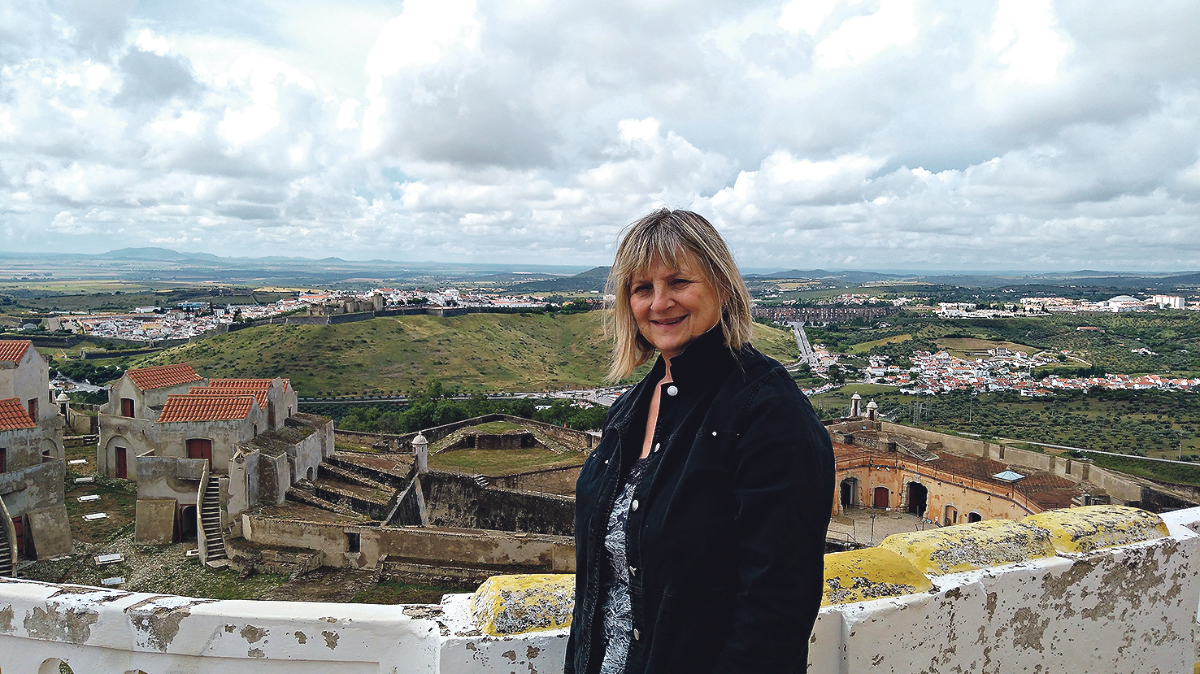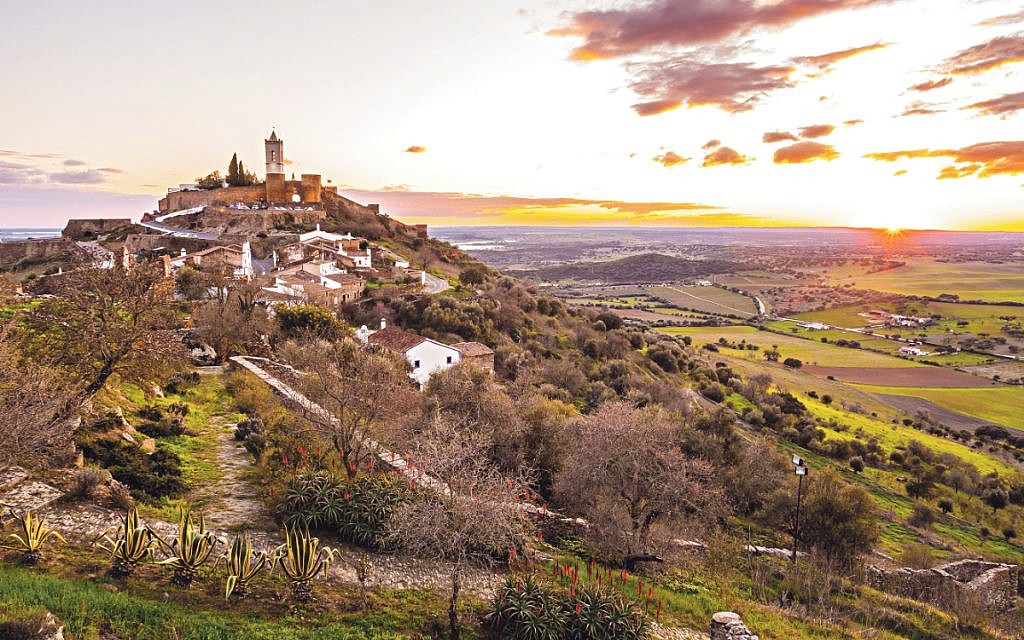The jewel in Portugal’s crown
Lucy Daltroff explores the unspoilt region of Alentejo, with its abundant natural beauty and medieval Jewish history
Looking out the window on the two-hour drive from Lisbon to the Alentejo region of Portugal, it seems almost every power pylon has a large stork’s nest perched on top, with chicks peering over the rim.
They look healthy enough, but I can’t help worrying about the long-term implications of their precarious home location.
Alentejo literally means “beyond the Tejo” (Tagus river) and the region has a raw rural beauty, with extensive undulating plains, fields of cork trees and numerous vineyards.
Get The Jewish News Daily Edition by email and never miss our top stories Free Sign Up
It’s situated in south central Portugal and although it covers almost a third of the country, it seems to have escaped mass tourism unlike the nearby Algarve.
I am here to visit its Unesco World Heritage attractions, which include towns, individual buildings and traditional handicrafts.
First stop is the region’s ancient and charming capital, Évora, historically a major trading and religious centre.
The city walls and majestic 1st Century Corinthian Temple point to its ancient past – author Pliny the Elder mentioned his visit – but it’s no museum-like metropolis because it’s also a thriving university town.

Everywhere there is unusual architecture, and long winding cobbled streets, which all lead to the historical Giraldo Square.
In the Middle Ages, Évora was the second city of Portugal and had one of the most extensive Jewish quarters, with around 150 communities overall. Within a small group of streets and alleyways, stood two synagogues, the baths, and a hospital. Sadly, not much of Évora’s Jewish past is still visible today.
This is not the case just 30 miles up the road at Estremoz. This fortified town is divided into two distinct parts; the flat lower commercial area called “vila nova” and the “cidade velha” by the castle.
Here the medieval Jewish presence is more visible and I was able to see houses with distinct indentations where mezuzahs were once fixed.
Estremoz is often referred to as the “white city” and it is true that most of the houses dazzle in the sun, but it really gets its nickname from marble. Everything is made of the stuff, from humble doorsteps to cobblestones. As our guide, Luis, explained: “Portugal is the second largest exporter of marble in the world – only the Carrara area in Italy is bigger – and 85 percent of it comes from round here.”
But my real purpose is to see the local artisan tradition of clay figure-making; a 17th Century craft that now has Unesco status. Each piece consists of three sections and, after 12 hours firing in the oven, they are then dressed in either the regional attires of Alentejo, or as part of religious Christian iconography.
Although you can view the figures in the museum, I preferred visiting the Irmãs Flores workshop where they are fired, painted and sold.
One of the two Flores sisters told me she had been doing this work since she was 13. The finished results are relatively cheap, costing less than €50 (£44), although as she explained, “prices have risen a little since Unesco status was conferred in 2017”.
It’s difficult to visit Alentejo without mentioning the importance of the ubiquitous cork trees. The trade provides employment for about 60,000 workers and it’s the only tree where the regular stripping of the bark causes absolutely no damage.
The cork is gathered during mid-summer, by teams using locally-made hand-axes. Cork uses include flooring and the inside of cricket balls but, most famously, as a bottle stopper. We are told the harvest of one mature tree provides sufficient bark to produce about 4,000 corks.
In the attractive walled village of Monsaraz, we drank wine and ate my favourite Portuguese delicacy, pastéis de nata (custard tarts), while looking over to Alqueva Lake, one of the biggest artificial lakes in Europe.
Owing to its elevation, Monsaraz has always occupied an important place in history and, in 2016, a special Jewish Interactive Centre, was opened in memory of 80 former residents who were persecuted 500 years ago during the Portuguese inquisition.
Its purpose is to explain more about the Portuguese Jewish community, an initiative that is a part of both Spain and Portugal’s current investment in preserving their 16th century Jewish heritage.
Since 2013, both countries have passed laws allowing the descendants of Sephardic Jews to become citizens, in what was described as “an act of atonement for the inquisition”.
The museum in Monsaraz is a simple white structure with just a couple of rooms on two floors and a permanent film show.
It explains that Jewish quarters existed in every town – mainly to restrict interaction between Christians and Jews. This was even more of an issue after 1492 when the already substantial community of Portugal grew, after tens of thousands emigrated from neighbouring Spain as a result of the Spanish inquisition.
In 1536, Portugal had its own Inquisition and Jewish citizens were stripped of their possessions, forcibly converted to Christianity or made to leave, while thousands more were killed.
The current Jewish population in Portugal now stands around 1,000. Recently, the government allocated more than £4million to the Portuguese Jewish Network Sefarad Routes, a state-funded project for preservation works at sites connected to the country’s Jewish past.
This will include the renovation of the ancient synagogue in the municipality of Elvas, another of Portugal’s hidden gems.
Travel tips
Lucy travelled on the Heathrow Express (heathrowexpress.com) and flew with TAP Airlines (flytap.com), which offers direct flights from London City Airport, Heathrow, Gatwick and Manchester to Lisbon. Prices start at £43 one way. She stayed at Vila Galé Évora (vilagale.com/en) and Casa do Terreiro do Poço, Borba (hotel-casa-do-terreiro-do-poco-borba.vivehotels.com/en). For more information, see visitportugal.com/en

Thank you for helping to make Jewish News the leading source of news and opinion for the UK Jewish community. Today we're asking for your invaluable help to continue putting our community first in everything we do.
For as little as £5 a month you can help sustain the vital work we do in celebrating and standing up for Jewish life in Britain.
Jewish News holds our community together and keeps us connected. Like a synagogue, it’s where people turn to feel part of something bigger. It also proudly shows the rest of Britain the vibrancy and rich culture of modern Jewish life.
You can make a quick and easy one-off or monthly contribution of £5, £10, £20 or any other sum you’re comfortable with.
100% of your donation will help us continue celebrating our community, in all its dynamic diversity...
Engaging
Being a community platform means so much more than producing a newspaper and website. One of our proudest roles is media partnering with our invaluable charities to amplify the outstanding work they do to help us all.
Celebrating
There’s no shortage of oys in the world but Jewish News takes every opportunity to celebrate the joys too, through projects like Night of Heroes, 40 Under 40 and other compelling countdowns that make the community kvell with pride.
Pioneering
In the first collaboration between media outlets from different faiths, Jewish News worked with British Muslim TV and Church Times to produce a list of young activists leading the way on interfaith understanding.
Campaigning
Royal Mail issued a stamp honouring Holocaust hero Sir Nicholas Winton after a Jewish News campaign attracted more than 100,000 backers. Jewish Newsalso produces special editions of the paper highlighting pressing issues including mental health and Holocaust remembrance.
Easy access
In an age when news is readily accessible, Jewish News provides high-quality content free online and offline, removing any financial barriers to connecting people.
Voice of our community to wider society
The Jewish News team regularly appears on TV, radio and on the pages of the national press to comment on stories about the Jewish community. Easy access to the paper on the streets of London also means Jewish News provides an invaluable window into the community for the country at large.
We hope you agree all this is worth preserving.
-
By Brigit Grant
-
By Laurent Vaughan - Senior Associate (Bishop & Sewell Solicitors)
-
By Laurent Vaughan - Senior Associate (Bishop & Sewell Solicitors)
-
By Laurent Vaughan - Senior Associate (Bishop & Sewell Solicitors)
-
By Laurent Vaughan - Senior Associate (Bishop & Sewell Solicitors)






















